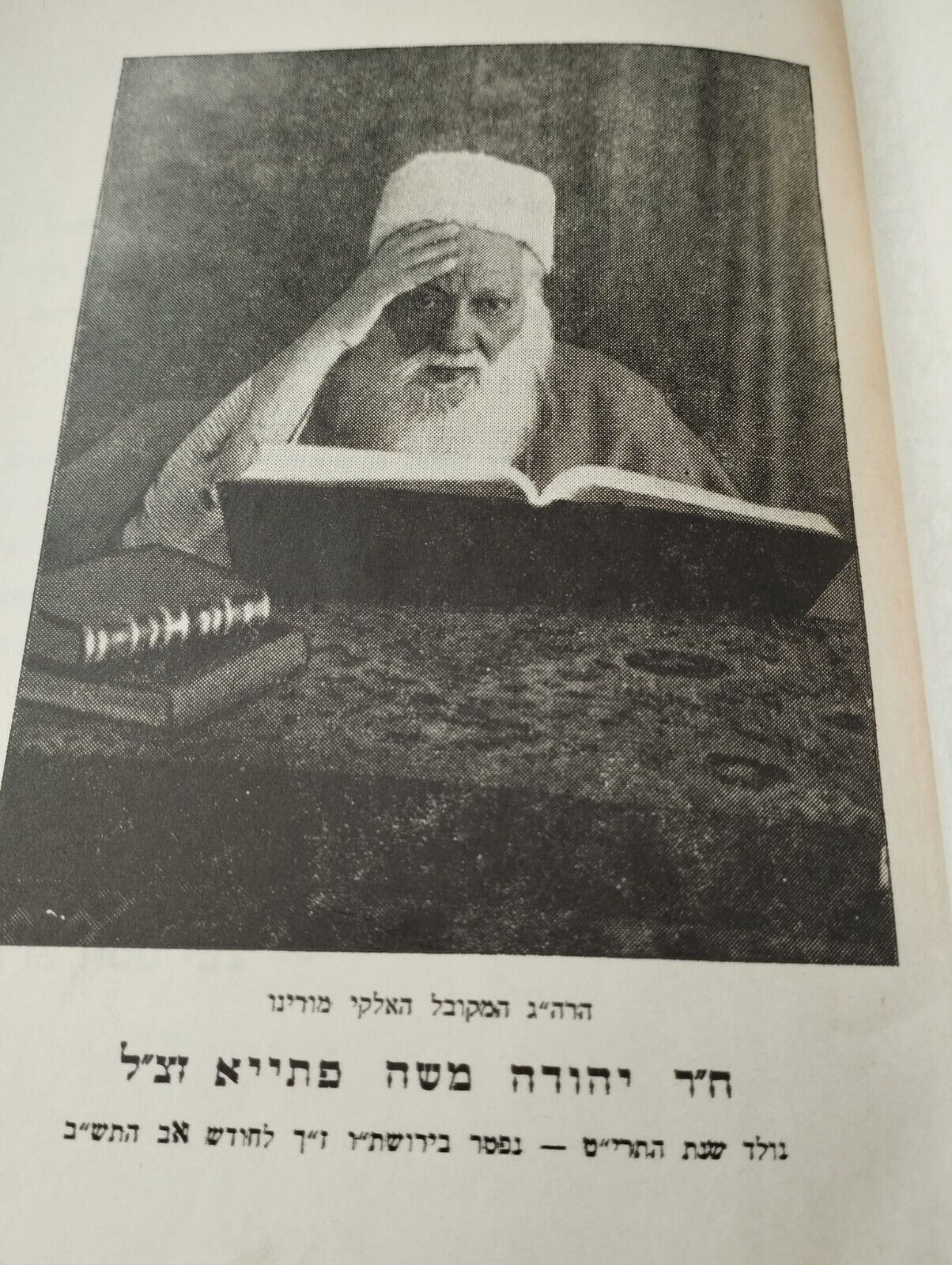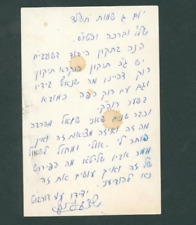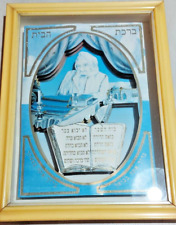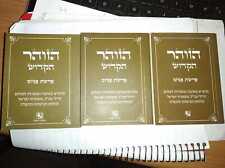When you click on links to various merchants on this site and make a purchase, this can result in this site earning a commission. Affiliate programs and affiliations include, but are not limited to, the eBay Partner Network.
Title: Minchat Yehudah - Ruchot Mesaprot (Spirit's Tales), Jerusalem, 1956, 156 pages. Very good condition. (Hebrew)
This has got to be one of the most AMAZING books ever written on the Bible and Reincarnation from a Jewish Kabbalistic perspective.
On the surface, it is a Biblical Kabbalistic commentary by the great Kabbalist, Rabbi Yehudah Petaya of Blessed memory. That's the first section.The second section deals with Rav Petaya's personal experience of dealing with lost spirits who possessed people, or came to them in dreams etc and how he exorcized them. The Rabbi also asked these disembodied Spirits all kinds of questions as to how the Heavenly realms operate, whose in charge, the punishments for the wicked etc. Including is one story where Nathan of Gaza (Shabbtai Tzvi's promoter) appears but I won't spoil the story for you and just say that it has a happy? ending! This part of the book makes an especially fascinating read and should be read by every budding kabbalist.Book is in Hebrew.Here is some of the material to be found in this book:
"Along with the allusive meaning I also explain sometimes the meaning of dreams and their interpretations, so that a person may thereby recognize and distinguish a particular dream if it came by of an angel, or by demons, or destroyers. He will also be able to understand and interpret that dream without needing to consult experts on dream interpretation, all of which is explained in our commentary to the portion of Miketz [chapter 47].
This work also elucidates the topic of the World to Come, the resurrection of the Dead, the reward granted for observing the commandments, and the nature of the physical pleasure experienced by a righteous person who occupied himself with the Torah and its laws, as explained at the end of the portion of Va et hanan [chapter 69].Also addressed is the topic of the reincarnation of souls in the mineral, vegetable, animal and human kingdoms, the blessing for trees, the order in which the sacred sparks ascend and are purified, and the meaning of Satan s question, Where is the Torah? All this is explained in the beginning of the portion of Ekev [chapter 70].Also explained is the occurrence of plague and pestilence, see the commentary to Isaiah 26 [chapter 81]. Also explained is the matter of Hell, which is not mentioned in the Bible,
And the reincarnation of Nathan of Gaza the author of the book Hemdat Yamim , and how he was rectified. In the course of the discussion, the matter of rectifying naked souls will be addressed, see the commentary to Isaiah 30[chapter 82].Also explained is the issue of spirits which possess people and cause them to have seizures, may the Merciful One protect us, about which I recorded a number of stories in great detail.The matter of the beating in the grave is also described, that a person is asked their name in the grave, the purpose of that question, and what happens to a person after the beating in the grave. How he is presented to the Heavenly Court to give an account and reckoning of his actions. The benefits of repentance, the Pouch of the Slingshot, the reincarnations in the mineral, vegetable , animal and human kingdoms, the calculation of sentence in Hell, the entire sequence what befalls a man from the moment of his death until he merits to enter the Garden of Eden. Which actions are beneficial and useful to the soul of the deceased, to deliver and succor him from the suffering imposed on him by the Heavenly Court. Which subjects should be studied on the grave of the deceased, the implication of a deceased person appearing to his relatives in a dream, the angels of destruction appointed over a person, their facial features, the form of their bodies and what they eat, that a newborn child must not be named after a deceased person , unless he was clearly a righteous person, upright and honest, or at least to effect a rectification for that deceased before naming a child after him, also the text of the confession for a repentant man for the sins committed by his soul. as detailed in the commentary to Ezekiel 37[chapter 88].
These are the words of the most insignificant of all living, the novice
Yehuda ben Moses Joshua Fetaya".
BIOGRAPHY: RAV YEHUDAH FETAYA Z"L
Hacham Yehuda Fetaya, son of kabbalist Hacham Moshe Yeshua Fetaya, was born on 2 Shevat 5619 (1859) in Baghdad, Iraq. As a child, he studied at the Midrash Beit Talmud Torah and later at the Midrash Beit Zalicha. He received most of his Torah learning from his teacher, Hacham Yoseph Balbul.
In 1876, at the age of 17, he was asked by Rosh Yeshiva Hacham Abdallah Sumech to stand before the Arkand lead prayers. One of those present remarked that a young person whose beard is not yet full should not be appointed to be the Hazan. In response, Hacham Abdallah Sumech stood up and left his seat, placing his hands on Hacham Yehuda Fetaya, in effect ordaining him as a rabbi and as a teacher of Jewish law.
While still a young man, he resolved to study Kabbala. His father, kabbalist Hacham Moshe Yeshua Fetaya, taught him the Zohar and the ARI's writings by heart. In 1884, at the age of 25, Hacham Yehuda Fetaya wrote his first mystical work, entitled Ya'in Harekach. He became famous for the depth of his knowledge of invocations and amulets. He would heal the sick, using both mystical and known methods.
Hacham Yehuda Fetaya prayed at the Yitzhak Avraham synagogue and eventually served as Rosh Yeshiva of the Midrash Beit Zalicha, where, in 1925, he began to teach the Etz HaHaim Kabbalistic book to a select group of sages.
He immigrated to Israel three times during the course of his lifetime; in 1905, in 1923, and in 1933, when he definitively settled in Jerusalem.
In 1937 Hacham Yehuda Fetaya fell ill and was hospitalized in Jerusalem's Sha'arei Tzedek hospital. Kabbalist Hacham Salman Mutsafi, his student, prayed for his recovery at Rachel's Tomb, and he was granted five additional years of life…
Hacham Yehuda Fetaya passed away on 27 Av, 5702 and was buried at the summit of the Bavli community's cemetery on the Mount of Olives.
Hacham Yehuda Fetaya wrote many books, some of which are still in manuscript form. His published books include Minhat Yehuda - commentaries on the Bible, Talmud, and Kabbala that includes conversations with dybbuks and the rite for dybbuk removal (THIS BOOK); Beit Lehem Yehuda – a commentary on Etz Haim; Ya'in HaRekach – a commentary on the Zohar, both the Idra Rabba and Idra Zuta; Ateret Rachel – sermons of Ethics of Our Fathers, and Keter Tzeddek – on the Torah. Assirei HaTikva and Hasdei David both contain supplications and prayers.
A few quotes from the Rabbi on 'Love of Israel' in which he explains that the wise will seek repair (tikun) and take pains to bring the sinful to repent
"For their feet run to evil; They hurry to shed blood". This can be interpreted as praise. Fully righteous people are accustomed to pursuing tikun in their towns. When they encounter a problematic person who commits wicked deeds they go, on their own, to the person's home and speak to them in words of reprimand and morals, until they lead the person's heart to change their ways and convince them to end their evil-doing. And should these righteous people need to spend money for this matter, they do so from their own pockets and not from the community's funds. This is what is meant by "their feet run" – those of the righteous – "to evil" people – to have them repent. And if funds are required, "they hurry to shed blood" – the word blood (dam)in this case means monies (damim). "They are clever at wrongdoing" can also be interpreted to mean that the wise go to great lengths with wrongdoers to straighten them out, and "but know not to do right" as their having no issue with those who do right.









